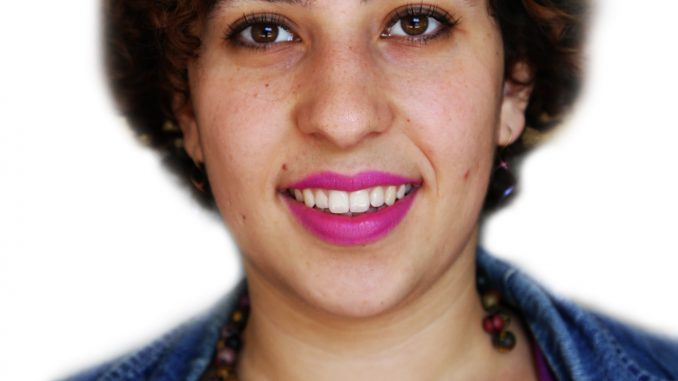
If you passed the Bell Tower between 10-11 a.m. on Oct. 22, you may have seen me pacing back and forth in the rain. If you looked closer, you probably saw that I was contained within a 7-by-9-foot rectangle taped off on the ground. I was participating in a demonstration called “Mock SHU” for the Coalition to Stop Police Brutality Repression and the Criminalization of a Generation’s annual Day of Protest. If you have ever had a loved one in prison, you probably know that SHU stands for Solitary Housing Unit – in other words, solitary confinement.
Mock SHU is intended to call attention to the practice of putting inmates in solitary confinement, which many consider inhumane. The average size of a cell in the SHU is 7-by-9, according to Revolution Newspaper. Prisoners are usually held there for 23 hours a day, without access to any human interaction, and are allowed outside in another space for one hour of “recreation.” For this reason, in Mock SHU demonstrations the cell is occupied for 23 hours and empty for the final hour.
During the protest on Main Campus, the first student stepped inside the cell at 5 p.m. on Oct. 21, replaced by another student for each of the next 23 hours.
The United Nations special reporter on torture and inhumane punishment, Juan Méndez, told solitarywatch.com that “under no circumstances should [juveniles or people with mental health issues] ever be subjected to solitary confinement,” and that even for mentally healthy adults “anything beyond 15 days of solitary confinement” should be “completely banned.”
In the United States, both convicted minors and adults are subjected to solitary confinement and mental health is rarely a consideration, according to the American Civil Liberties Union. In 2003, the Department of Justice estimated, based on survey data, that one-third of youth in custody are at some point held in solitary confinement.
When I heard that the Mock SHU demonstration was being organized at Temple, I knew I wanted to participate. I knew from personal experience that the SHU is what many people in prison fear most deeply. I recently completed the Inside-Out Program, a course in which the professor and students travel to a prison every week so that a number of inmates can participate as students. My incarcerated former classmates told me an inmate can be sent to the SHU for any alleged infraction, or even for no reason at all.
What I did not expect when I stepped into the mock cell that morning was how deeply it would affect me.
Let me be clear, my safety and well-being were never at risk. I have never been arrested or imprisoned. I was in broad daylight. There were no walls or a ceiling in my cell. I was not afraid for my life or my physical and mental safety. I knew that I could access food and health care whenever I needed it. And most obviously, I knew I would only be there for one hour, and I could leave at any moment if I really wanted to.
Despite all of this, I began to feel claustrophobic by minute seven. I began to experience extreme anxiety around minute 15. My thoughts were racing, my heart rate sped up. I was jittery, and time passed slowly.
All I could think about in the cell was if someone like me was this uncomfortable and emotional from something as trivial as standing in the same place for one hour, what could it possibly be like to be forced there for weeks or months at a time with little to no control over my life, and no social interaction whatsoever? This is unimaginable for those that have never experienced it, and truly terrifying.
Rose Daraz, a senior journalism major, also took part in the demonstration. Daraz said she feels the program was effective.
“So many people … ask[ed] questions and were nodding their heads in agreement walking by,” she said.
I previously wrote an article for The Temple News about the private prison industry, after two Temple economics professors conducted a study called unethical by critics since they accepted funding from the industry itself. Since then, 30 academics from around the country wrote a joint letter to Temple’s Board of Trustees condemning the study and calling for the disclosure of funding sources. The letter, posted on truth-out.org, asserts that the study was funded “by the very industry that is the subject of the study and which stands to benefit from the findings.” One of the signatories was civil rights litigator and legal scholar Michelle Alexander whose book “The New Jim Crow” recently made waves by asserting that the criminal justice system unfairly targets people of color the way infamous Jim Crow laws of the past did, and thus suppresses the advancement of the whole community.
The Mock SHU demonstration called out the specific practice of solitary confinement, but was also meant to call attention to mass incarceration and police brutality, which scholars like Alexander see as intimately related aspects of the same system. Daraz agreed.
“Black and Latino kids are being targeted and directed into this school to prison pipeline,” she said. Daraz said she feels a personal responsibility to get involved with advocacy against abuse within the criminal justice system.
“College students, specifically Temple University students, should get involved with this because we are partially responsible,” Daraz said. “Our tuition money is going to those police officers arresting black children in the neighborhood.”
Daraz paints a grim picture, but like her, I believe it does not have to be this way. The more people like us, college students, use our place of privilege to stand in solidarity with the incarcerated, the closer we can get to dismantling an unjust system.
Sarah Giskin can be reached at sarah.giskin@temple.edu and on twitter @SarahBGisky


Be the first to comment